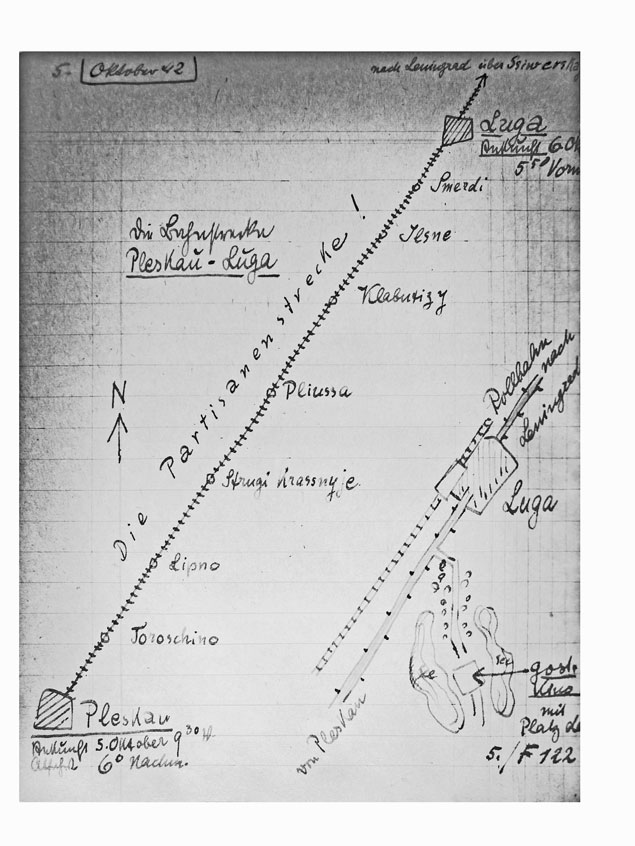- Home
- POSTER GALLERY
- ❗️BOOK & POSTER STORE❗️
- PURCHASE "HJ Quex" film ephemera HQ
- About the Posters
- The William Gillespie Collection
- Our Publishing House
- ❗️GFDN interviews author and collector William Gillespie ❗️
- Our most expensive & inexpensive finds!
- ❗️***NEW!**❗️POSTER OF THE MONTH - Blutzeugen / Raza
- ❗️NEW ❗️Film Posters – Demands on an important means of film advertising. ❗️
- In our Book + Zeitschrift Library
- ❗️ ***NEW!*** Hitler Youth Quex – A Guide for the English–speaking Reader ***NEW!*** ❗️
- ❗️***NEW!*** Table of Contents of our new HJ QUEX book❗️
- ❗️Hitler Youth Quex Guide - early praise! ❗️
- Recent loans from the Collection
- Farewell Horst Claus. (1940–2024 †)
- "Der Deutsche Film" Zeitschrift
- ❗️ ***NEW!***Reichsfilmkammer collection ❗️
- German "Tendency" Films (Tendenzfilme) in the Third Reich
- KARL RITTER
- Karl Ritter original film posers in this Collection
- "Besatzung Dora" ( † 1943)
- "The Making of The Crew of the Dora"
- Karl Ritter at the 1938 Reichsfilmkammer Congress
- INDEX -"Karl Ritter" book, 2nd edition
- Karl Ritter's Legion Condor (1939, unfinished)
- Excerpt from our "Dora" book
- ∆∆∆∆∆ High praise for our DORA book! ∆∆∆∆∆
- TABLE OF CONTENTS – "Legion Condor"
- § § § § § Early Praise for our LEGION CONDOR book! § § § § §
- ❗️"Das Leben geht weiter" and Karl Ritter ❗️
- Dateline: Ufa - April 11, 1945
- Zarah Leander Europe–wide !
- Japan Military Film and Karl Ritter
- Karl Ritter after 1945
- 1935 Film Congress
- Poster Exhibition in Berlin, March 1939
- Potsdam poster exhibition 12 April–25 August 2019
- Leni Riefenstahl's two "Olympia" Films (1938)
- "Ohm Krüger" (1941)
- Emil Jannings
- "Blutendes Deutschland" (1933)
- Hannes Stelzer ( † 1944)
- Klaus Detlef Sierck ( † 1944)
- Film stills
- Reich Film Censorship Offices
- ❗️***NEW!***The Fate of the German Film Industry in May 1945 ❗️
- Film censorship cards
- Film Archives
- Cinema advertising
- School filmstrips
- ❗️UPDATED❗️ Z F O / Ostland Film G-m-b-H
- Z F O / Herbert Jacobi estate
- ZFO / Ostland Film newspaper articles
- ❗️***NEW!*** Roter Nebel / Red Fog / Red Mist (1942/1943, ZFO) ❗️
- ZFO - Der Rückkehrer - The Returnee (1943/1944)
- The D F G production company
- D I F U
- ❗️ ***NEW!*** "Carl Peters" – Special Collection. ❗️
- "Alcazar" (1940, Genina)
- "Der 5. Juni" (1943, banned)
- Herbert Selpin and his "Titanic" (1943)
- Ein Robinson (1940, Fanck)
- "Fronttheater" (1942)
- Veit Harlan's Jud Süß and Fritz Hippler's Der Ewige Jude
- Harlan "Jud Süß" trial 1949
- Werner Krauss & JUD SÜß
- Anti-Semitic Film Posters in the Collection
- "Heimkehr" (1941)
- "Hitlerjunge Quex" (1933)
- ❗️***NEW!*** Hitlerjunge Quex in 111 Greater Berlin Cinemas ❗️
- Jürgen Ohlsen
- "S.A.Mann Brand" (1933)
- "In der roten Hölle" (Edgar Neville, 1939)
- "Helden in Spanien" (1938)
- The Spanish Civil War in Film
- Andrews Engelmann (1901 – 1992)
- Deutsche Wochenschau
- Uƒa Feldpost
- Uƒa Kulturfilm – Informationen
- " Die Tochter des Samurai" (1937, Fanck)
- Ufa 25th Anniversary
- Invitations to world premieres
- ❗️***NEW!*** Continental Films, Paris 1940–1944 ❗️
- Film Censorship in Occupied Paris 1942
- "Der Sieg des Glaubens" (1933)
- Wilhelm Althaus Estate
- Weimar Germany posters
- Ufa and the Ordensburgen
- The Gaufilmstelle in our Collection
- "Zwei Welten" (1940)
- "Capriccio" (1938) –Karl Ritter film album
- Unrealised NS Propaganda Films 1934–1945
- German Film Directors accused of "war crimes"
- Australian––themed NS feature films
- "Der Störenfried" / "The Troublemaker"
- What was new in 2014?
- What was new in 2015?
- What was new in 2016?
- What was new in 2017?
- What was new in 2018?
- What was new in 2019?
- What was new in 2020?
- What was new in 2021?
- What was new in 2022?
- What was new in 2023 ?
- What's new in 2024?
- ❗️***NEW!*** Hitler assassination attempt in Karl Ritter film cut❗️
- BESATZUNG DORA private photos
- Just discovered 1942 article on BESATZUNG DORA
- The Karl Ritter Tetralogy
- Google Analytics 2023
- Our first–ever acquisition!
- ❤️"Some of our favourite things....!"❤️
- ERRATUM for our " Hitler Youth Quex Guide"
- Trending
- Vale †
- Our Wants List / 2024 / Wunschliste
- Pop Quiz
- Unsere KARL RITTER Bücher in Deutschland liefbar!
- WHERE to buy our books right now?
- ✉️Contact
 “History is not about the facts. It is about the context and who is telling the story.” —Prof. Milton Fine.
“History is not about the facts. It is about the context and who is telling the story.” —Prof. Milton Fine.
"Who controls the past controls the future: who controls the present controls the past." –– George Orwell in his novel "1984."
"Whoever doubts the exclusive guilt of Germany for the Second World War destroys the foundation of post–war politics." –– Prof. Theodor Eschenberg, Rector, the University of Tübingen.
"If we have our own why in life, we shall get along with almost any how." – Friedrich Nietzsche
POSTER GALLERY --view
over 500 German film
original posters between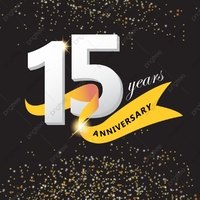
1927–1954 from
Germany and from
many Axis and Neutral countries
across Europe!
Note! Posters in the Poster Gallery are PERMANENT
acquisitions which are NOT FOR SALE!! ONLY the
posters listed in our POSTER STORE are for sale.
(They have a price and order button to use.)
Karl Ritter's BESATZUNG DORA (1943,
banned) behind–the–scenes private snapshots
taken in October 1942 in the Occupied Soviet
Union during filming.
We announce here some private photos taken during the film–shoot of Karl Ritter's Luftwaffe film Besatzung Dora in the USSR in October 1942. They are in a Wehrmacht soldier's album, unlabelled, which we acquired in September 2018 in Berlin at auction. The auction listing attributed the few photographs in the album to Ritter's Stukas film of 1941. This auction took place 9 weeks after we discovered the long–lost film script for Karl Ritter's Legion Condor feature film during the same visit to Berlin. We became totally focused on researching, writing and publishing our new book on that film, and this photo album was put on the proverbial back–burner until now.
We know that the photo album snapshots are definitely not from Stukas for a  number of reasons. First, the camera photo (see left) has the clapperboard with the Ufa Film number and RITTER-PROD. shown. Even though the film title is obscured, Ufa Film Nr. 1051 is Besatzung Dora. Secondly, Gottfried Ritter was not on the Stukas' film team, but was on Dora's as A.D. to his father, and was also the film's Editor back in Ufastadt–Babelsberg. Third, the 'Feindflug' enemy sortie scene with the garlands and victory arch as shown being constructed and matching the film's lobby card, is proof positive. Finally, there are photos in Karl Ritter's private diaries which show the Gostkino air base Officer's Mess which align with photos in the album, such as the one with actor Joseph Dahmen.
number of reasons. First, the camera photo (see left) has the clapperboard with the Ufa Film number and RITTER-PROD. shown. Even though the film title is obscured, Ufa Film Nr. 1051 is Besatzung Dora. Secondly, Gottfried Ritter was not on the Stukas' film team, but was on Dora's as A.D. to his father, and was also the film's Editor back in Ufastadt–Babelsberg. Third, the 'Feindflug' enemy sortie scene with the garlands and victory arch as shown being constructed and matching the film's lobby card, is proof positive. Finally, there are photos in Karl Ritter's private diaries which show the Gostkino air base Officer's Mess which align with photos in the album, such as the one with actor Joseph Dahmen.
Anything to do with "DORA," -- the banned Luftwaffe air reconnaissance film from 1943 -- is exciting to us, although these photos, even had they been known at the time of purchase, would have missed our THE MAKING OF THE CREW OF THE DORA book's publishing deadline by more than two years.
Nonetheless, we are pleased to show some of them here for the first time:
Here are three snapshots of the film crew en route to the USSR. The first photo shows them waiting at the rail siding at Warka, Poland for a train bound to the Eastern Front.

Two photos of the Besatzung Dora film crew after they reached the Soviet Union. Note in the second photo the Ufa film studio personnel newsletter Ufa Feldpost is displayed. We have all ultra-rare issues from May 1943 through to the final issue dated December 1944 in our archives.

The unidentified rail station and tracks near the film shooting location. This is most probably Luga, 16 kilometers from the Luftwaffe's air base in Gostkino. This was the nearest railhead to the base.

The forested landscape surrounding some of the fllm–shoot. This most likely is adjacent to the village of Ropti, 8.3 kilometers from the air base, where we know from Ritter's diary the village scenes were filmed .
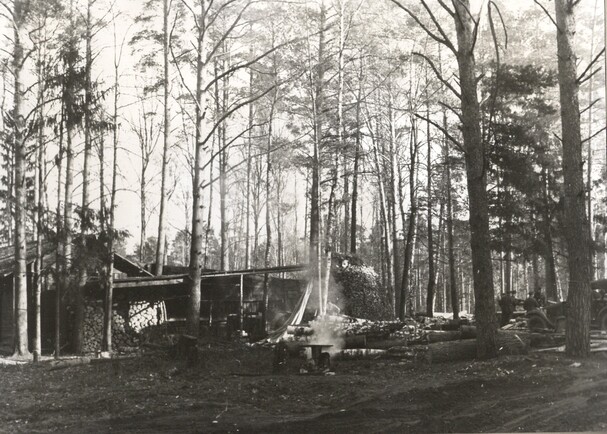
Here is a candid photo of soldiers making the signage to be used in the FEINDFLUG ceremony scene, spreading the materials out along the train tracks:
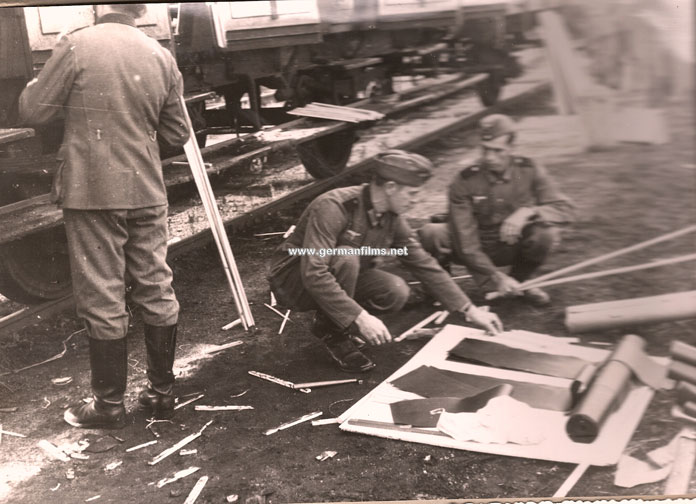
Here is the snapshot from the album of the Besatzung Dora scene with film actors and actual Luftwaffe personnel and air crews before the filming. (Note that behind the men is an aircraft, which does not appear in the Ufa film still).
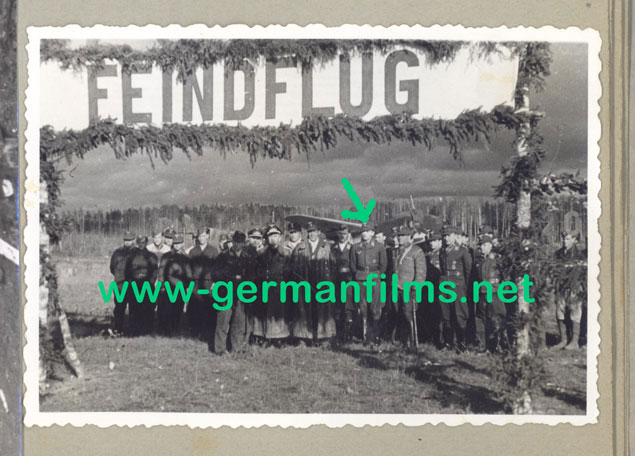
And here is the film scene as represented in the Ufa lobby card:

Here a candid shot of actor Joseph Dahmen 'conducting' in the Officer's Mess at the Gostkino Fliegerhorst in the Soviet Union, with soldiers looking on. The man at the extreme left of the photo in civilian clothes is Gottfried Ritter, Assistant Director to Karl Ritter, and his youngest son.
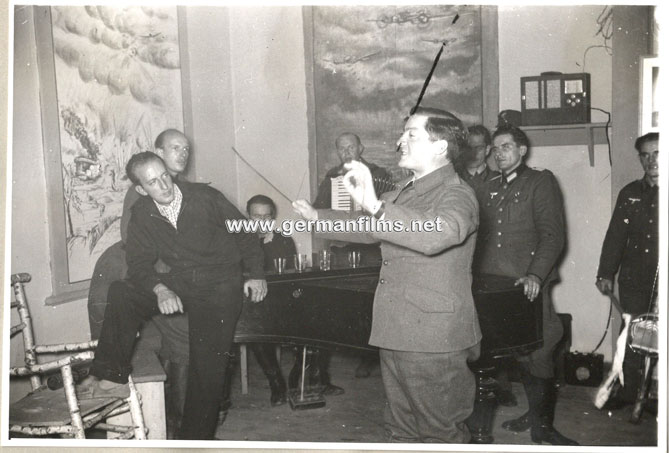
The Ufa camera crew (Gottfried Ritter at left) in the muddy road of the Soviet village on the outskirts of the Gostkino air base:
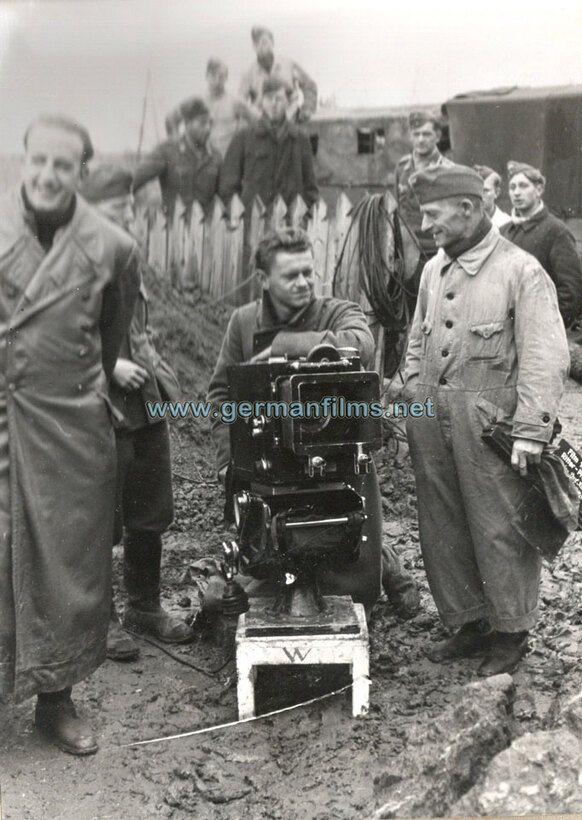
Compare the photo above with this press photo on the filming of the movie in a muddy road in the Occupied Soviet Union which appeared in the Berliner Illustrierte Zeitung Nr.50/1942:

....and compare the shrouded Ufa 35mm motion picture camera in the above clipping to the camera in the photo below:
The final album photo is that of Karl Ritter, in Luftwaffe uniform, arriving at the filming location in his car. Note the Ufa 35mm motion picture camera in a weather-proof shroud. This is the first time this image has been published, along with the above photos.
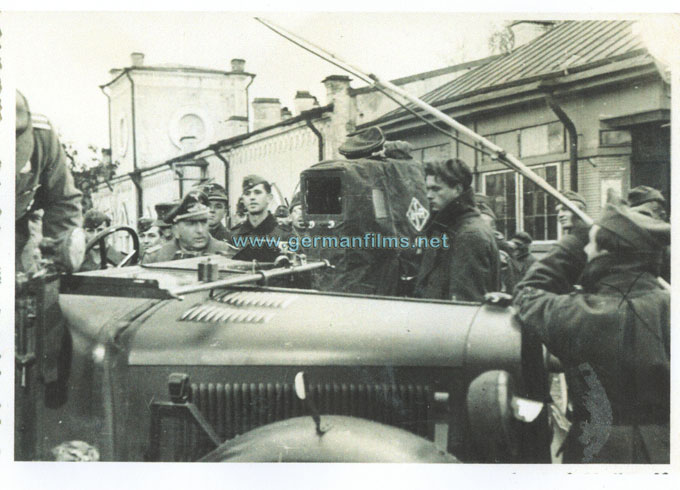
Our guess is that this photo was taken in the railhead town of Luga. 16 kilometers from the Gostkino air base. The village with muddy roads used in some film scenes was Ropti, 8.3 kilometers from the air base. We know today that Ropti's forest was a Partisan base used by a Commander Sherstnyov and forty-two guerillas. The area in which the Dora film was shot was a Partisan area, as shown in this map from Ritter's diary (and reprinted in our book):
